KIA Magnetis 2008 2.G Repair Manual
Manufacturer: KIA, Model Year: 2008, Model line: Magnetis, Model: KIA Magnetis 2008 2.GPages: 289, PDF Size: 4.78 MB
Page 61 of 289
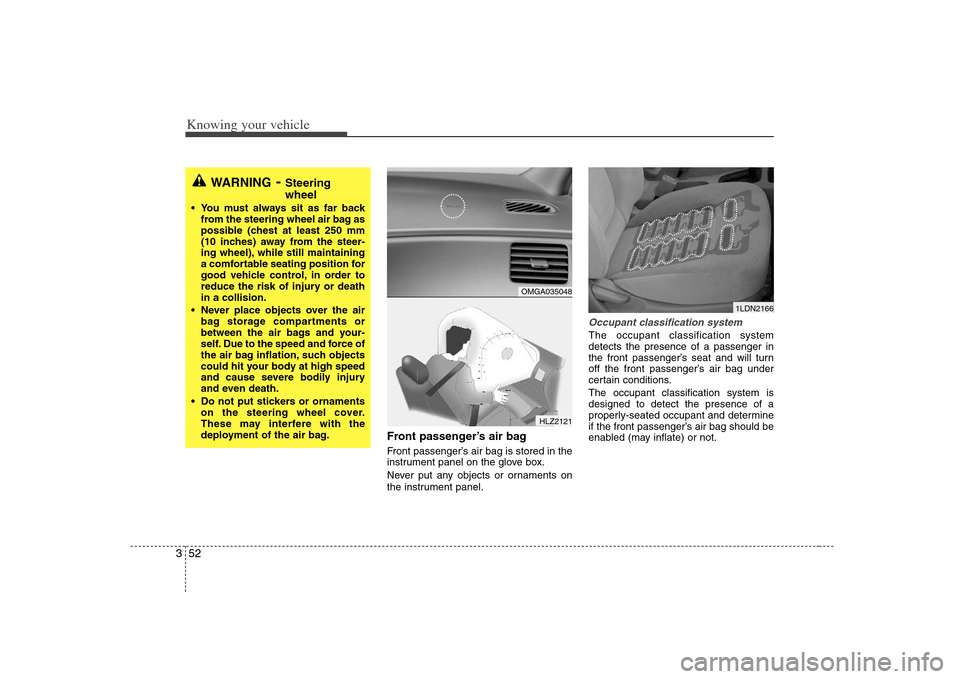
Knowing your vehicle52 3
Front passenger’s air bag Front passenger’s air bag is stored in the
instrument panel on the glove box.
Never put any objects or ornaments on
the instrument panel.
Occupant classification systemThe occupant classification system
detects the presence of a passenger in
the front passenger’s seat and will turn
off the front passenger’s air bag under
certain conditions.
The occupant classification system is
designed to detect the presence of a
properly-seated occupant and determine
if the front passenger’s air bag should be
enabled (may inflate) or not.
WARNING
- Steering
wheel
You must always sit as far back
from the steering wheel air bag as
possible (chest at least 250 mm
(10 inches) away from the steer-
ing wheel), while still maintaining
a comfortable seating position for
good vehicle control, in order to
reduce the risk of injury or death
in a collision.
Never place objects over the air
bag storage compartments or
between the air bags and your-
self. Due to the speed and force of
the air bag inflation, such objects
could hit your body at high speed
and cause severe bodily injury
and even death.
Do not put stickers or ornaments
on the steering wheel cover.
These may interfere with the
deployment of the air bag.
OMGA035048
HLZ2121
1LDN2166
Page 62 of 289
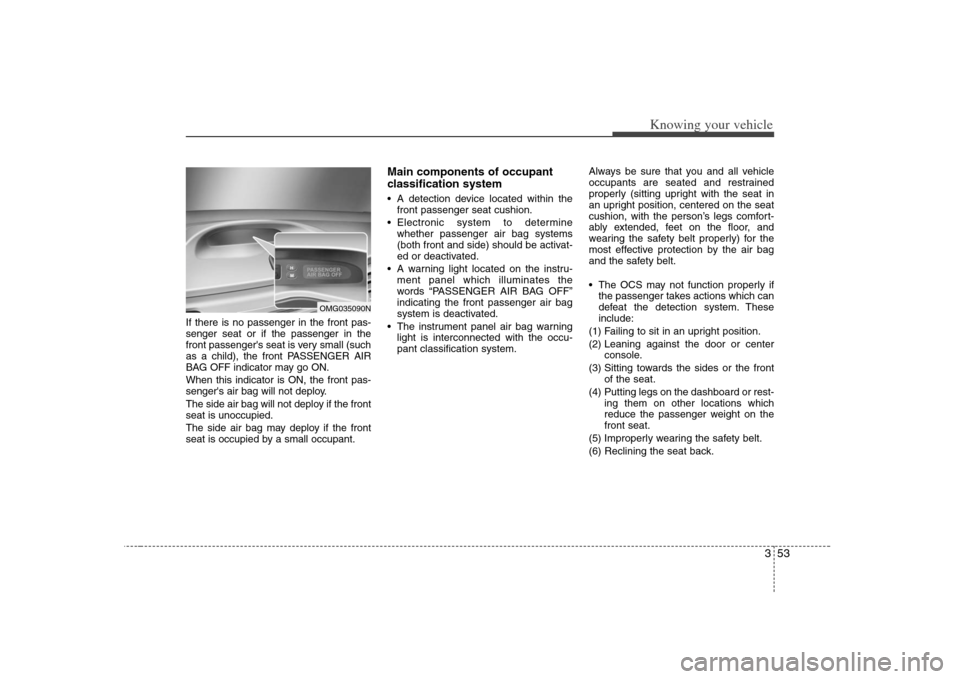
353
Knowing your vehicle
If there is no passenger in the front pas-
senger seat or if the passenger in the
front passenger's seat is very small (such
as a child), the front PASSENGER AIR
BAG OFF indicator may go ON.
When this indicator is ON, the front pas-
senger's air bag will not deploy.
The side air bag will not deploy if the front
seat is unoccupied.
The side air bag may deploy if the front
seat is occupied by a small occupant.
Main components of occupant
classification system A detection device located within the
front passenger seat cushion.
Electronic system to determine
whether passenger air bag systems
(both front and side) should be activat-
ed or deactivated.
A warning light located on the instru-
ment panel which illuminates the
words “PASSENGER AIR BAG OFF”
indicating the front passenger air bag
system is deactivated.
The instrument panel air bag warning
light is interconnected with the occu-
pant classification system.Always be sure that you and all vehicle
occupants are seated and restrained
properly (sitting upright with the seat in
an upright position, centered on the seat
cushion, with the person’s legs comfort-
ably extended, feet on the floor, and
wearing the safety belt properly) for the
most effective protection by the air bag
and the safety belt.
The OCS may not function properly if
the passenger takes actions which can
defeat the detection system. These
include:
(1) Failing to sit in an upright position.
(2) Leaning against the door or center
console.
(3) Sitting towards the sides or the front
of the seat.
(4) Putting legs on the dashboard or rest-
ing them on other locations which
reduce the passenger weight on the
front seat.
(5) Improperly wearing the safety belt.
(6) Reclining the seat back.
OMG035090N
Page 63 of 289
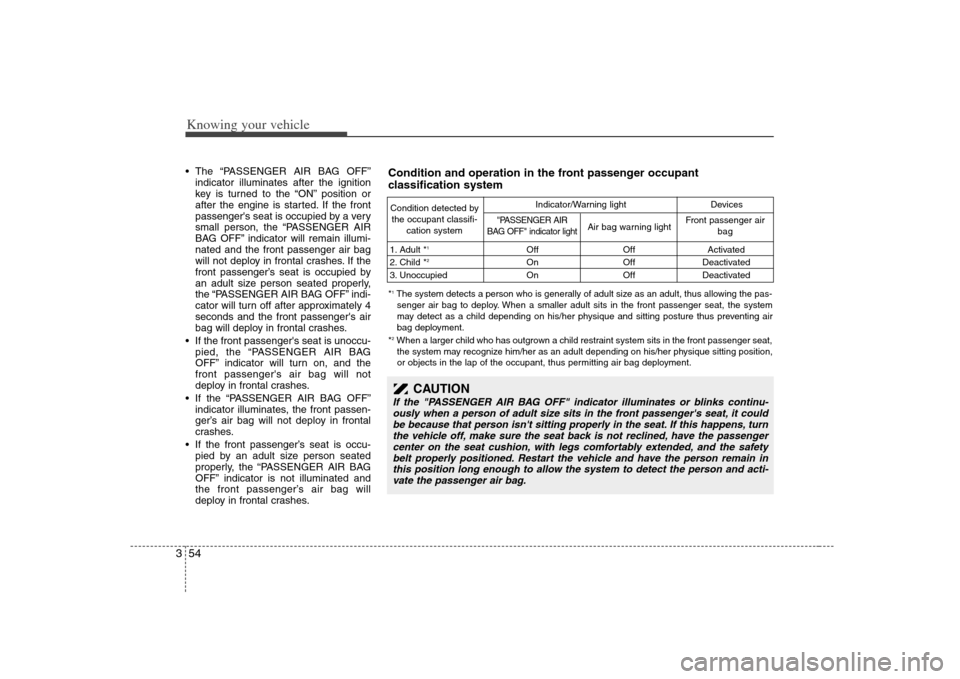
Knowing your vehicle54 3 The “PASSENGER AIR BAG OFF”
indicator illuminates after the ignition
key is turned to the “ON” position or
after the engine is started. If the front
passenger's seat is occupied by a very
small person, the “PASSENGER AIR
BAG OFF” indicator will remain illumi-
nated and the front passenger air bag
will not deploy in frontal crashes. If the
front passenger’s seat is occupied by
an adult size person seated properly,
the “PASSENGER AIR BAG OFF” indi-
cator will turn off after approximately 4
seconds and the front passenger's air
bag will deploy in frontal crashes.
If the front passenger's seat is unoccu-
pied, the “PASSENGER AIR BAG
OFF” indicator will turn on, and the
front passenger's air bag will not
deploy in frontal crashes.
If the “PASSENGER AIR BAG OFF”
indicator illuminates, the front passen-
ger’s air bag will not deploy in frontal
crashes.
If the front passenger’s seat is occu-
pied by an adult size person seated
properly, the “PASSENGER AIR BAG
OFF” indicator is not illuminated and
the front passenger’s air bag will
deploy in frontal crashes.
Condition detected by
the occupant classifi-
cation system
1. Adult *
1
2. Child *
2
3. Unoccupied Off
On
OnOff
Off
OffActivated
Deactivated
Deactivated
"PASSENGER AIR
BAG OFF" indicator light
Air bag warning lightFront passenger air
bag Indicator/Warning light Devices
*1The system detects a person who is generally of adult size as an adult, thus allowing the pas-
senger air bag to deploy. When a smaller adult sits in the front passenger seat, the system
may detect as a child depending on his/her physique and sitting posture thus preventing air
bag deployment.
*2When a larger child who has outgrown a child restraint system sits in the front passenger seat,
the system may recognize him/her as an adult depending on his/her physique sitting position,
or objects in the lap of the occupant, thus permitting air bag deployment.Condition and operation in the front passenger occupant
classification system
CAUTION
If the "PASSENGER AIR BAG OFF" indicator illuminates or blinks continu-
ously when a person of adult size sits in the front passenger's seat, it could
be because that person isn't sitting properly in the seat. If this happens, turn
the vehicle off, make sure the seat back is not reclined, have the passenger
center on the seat cushion, with legs comfortably extended, and the safety
belt properly positioned. Restart the vehicle and have the person remain in
this position long enough to allow the system to detect the person and acti-
vate the passenger air bag.
Page 64 of 289
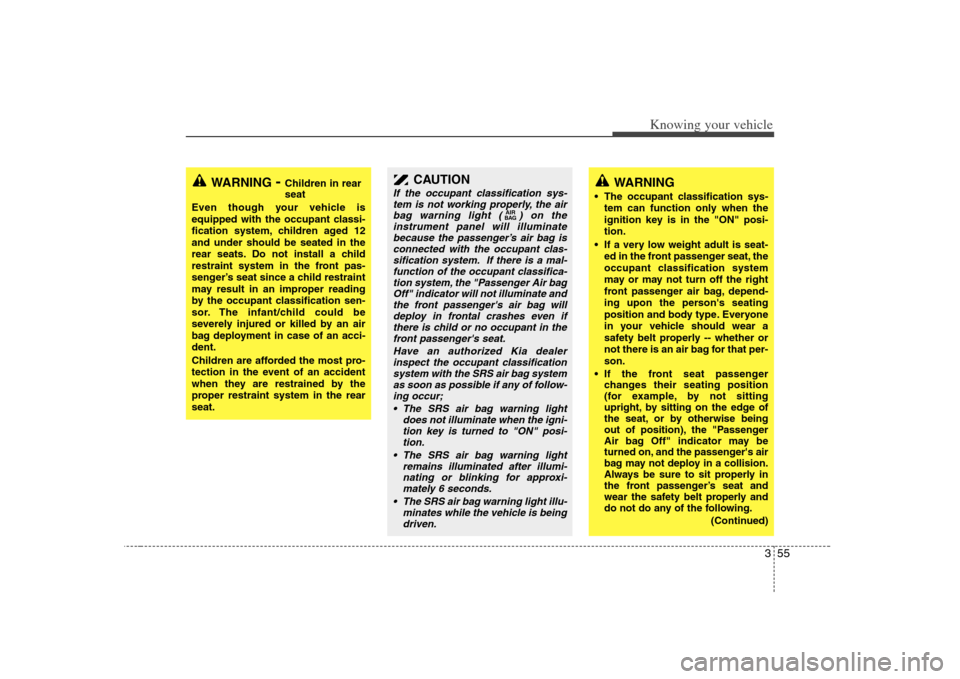
355
Knowing your vehicle
CAUTION
If the occupant classification sys-
tem is not working properly, the air
bag warning light ( ) on the
instrument panel will illuminate
because the passenger’s air bag is
connected with the occupant clas-
sification system. If there is a mal-
function of the occupant classifica-
tion system, the "Passenger Air bag
Off" indicator will not illuminate and
the front passenger's air bag will
deploy in frontal crashes even if
there is child or no occupant in the
front passenger's seat.
Have an authorized Kia dealer
inspect the occupant classification
system with the SRS air bag system
as soon as possible if any of follow-
ing occur;
The SRS air bag warning light
does not illuminate when the igni-
tion key is turned to "ON" posi-
tion.
The SRS air bag warning light
remains illuminated after illumi-
nating or blinking for approxi-
mately 6 seconds.
The SRS air bag warning light illu-
minates while the vehicle is being
driven.
AIR
BAG
WARNING
The occupant classification sys-
tem can function only when the
ignition key is in the "ON" posi-
tion.
If a very low weight adult is seat-
ed in the front passenger seat, the
occupant classification system
may or may not turn off the right
front passenger air bag, depend-
ing upon the person's seating
position and body type. Everyone
in your vehicle should wear a
safety belt properly -- whether or
not there is an air bag for that per-
son.
If the front seat passenger
changes their seating position
(for example, by not sitting
upright, by sitting on the edge of
the seat, or by otherwise being
out of position), the "Passenger
Air bag Off" indicator may be
turned on, and the passenger's air
bag may not deploy in a collision.
Always be sure to sit properly in
the front passenger’s seat and
wear the safety belt properly and
do not do any of the following.
(Continued)
WARNING
- Children in rear
seat
Even though your vehicle is
equipped with the occupant classi-
fication system, children aged 12
and under should be seated in the
rear seats. Do not install a child
restraint system in the front pas-
senger’s seat since a child restraint
may result in an improper reading
by the occupant classification sen-
sor. The infant/child could be
severely injured or killed by an air
bag deployment in case of an acci-
dent.
Children are afforded the most pro-
tection in the event of an accident
when they are restrained by the
proper restraint system in the rear
seat.
Page 65 of 289
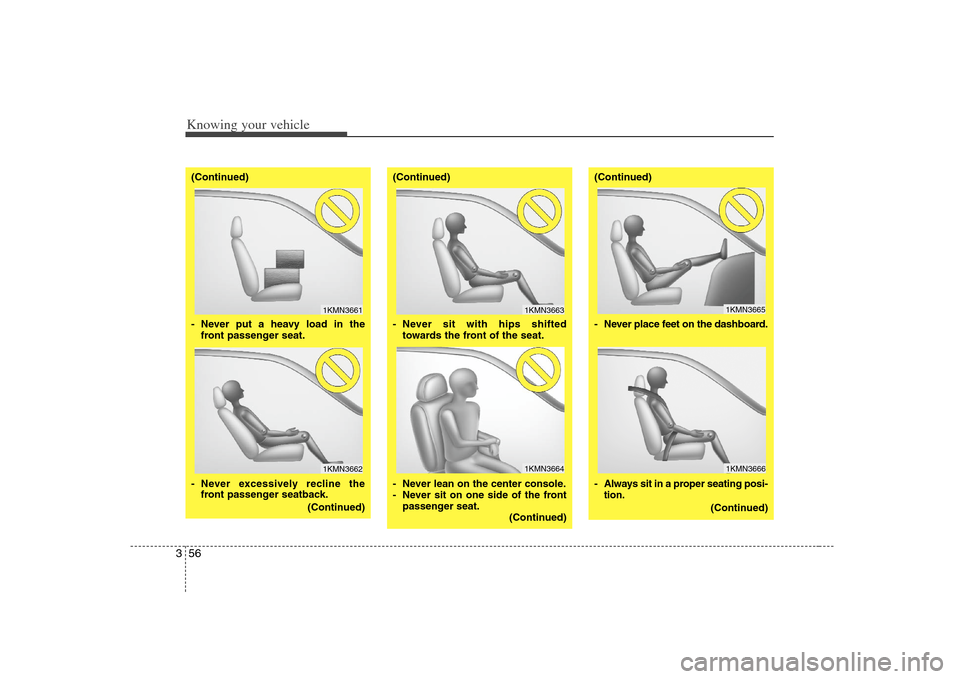
Knowing your vehicle56 3(Continued)
- Never put a heavy load in the
front passenger seat.
- Never excessively recline the
front passenger seatback.
(Continued)
1KMN36611KMN3662
(Continued)
- Never sit with hips shifted
towards the front of the seat.
- Never lean on the center console.
- Never sit on one side of the front
passenger seat.
(Continued)
1KMN36631KMN3664
(Continued)
- Never place feet on the dashboard.
- Always sit in a proper seating posi-
tion.
(Continued)
1KMN36651KMN3666
Page 66 of 289
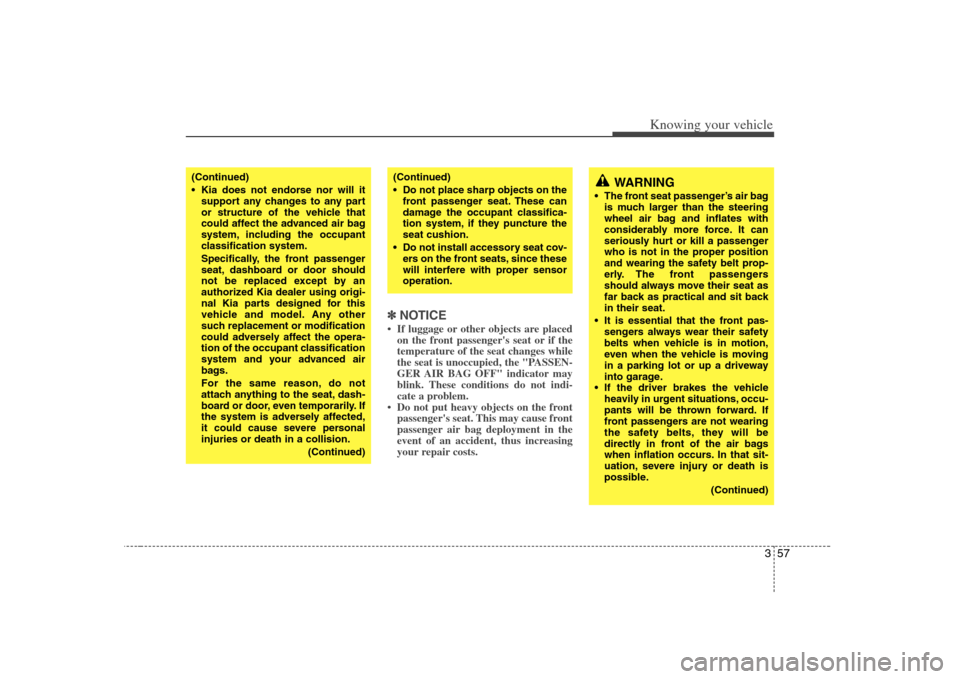
357
Knowing your vehicle
✽ ✽
NOTICE• If luggage or other objects are placed
on the front passenger's seat or if the
temperature of the seat changes while
the seat is unoccupied, the "PASSEN-
GER AIR BAG OFF" indicator may
blink. These conditions do not indi-
cate a problem.
• Do not put heavy objects on the front
passenger's seat. This may cause front
passenger air bag deployment in the
event of an accident, thus increasing
your repair costs.
(Continued)
Kia does not endorse nor will it
support any changes to any part
or structure of the vehicle that
could affect the advanced air bag
system, including the occupant
classification system.
Specifically, the front passenger
seat, dashboard or door should
not be replaced except by an
authorized Kia dealer using origi-
nal Kia parts designed for this
vehicle and model. Any other
such replacement or modification
could adversely affect the opera-
tion of the occupant classification
system and your advanced air
bags.
For the same reason, do not
attach anything to the seat, dash-
board or door, even temporarily. If
the system is adversely affected,
it could cause severe personal
injuries or death in a collision.
(Continued)
(Continued)
Do not place sharp objects on the
front passenger seat. These can
damage the occupant classifica-
tion system, if they puncture the
seat cushion.
Do not install accessory seat cov-
ers on the front seats, since these
will interfere with proper sensor
operation.
WARNING
The front seat passenger’s air bag
is much larger than the steering
wheel air bag and inflates with
considerably more force. It can
seriously hurt or kill a passenger
who is not in the proper position
and wearing the safety belt prop-
erly. The front passengers
should always move their seat as
far back as practical and sit back
in their seat.
It is essential that the front pas-
sengers always wear their safety
belts when vehicle is in motion,
even when the vehicle is moving
in a parking lot or up a driveway
into garage.
If the driver brakes the vehicle
heavily in urgent situations, occu-
pants will be thrown forward. If
front passengers are not wearing
the safety belts, they will be
directly in front of the air bags
when inflation occurs. In that sit-
uation, severe injury or death is
possible.
(Continued)
Page 67 of 289
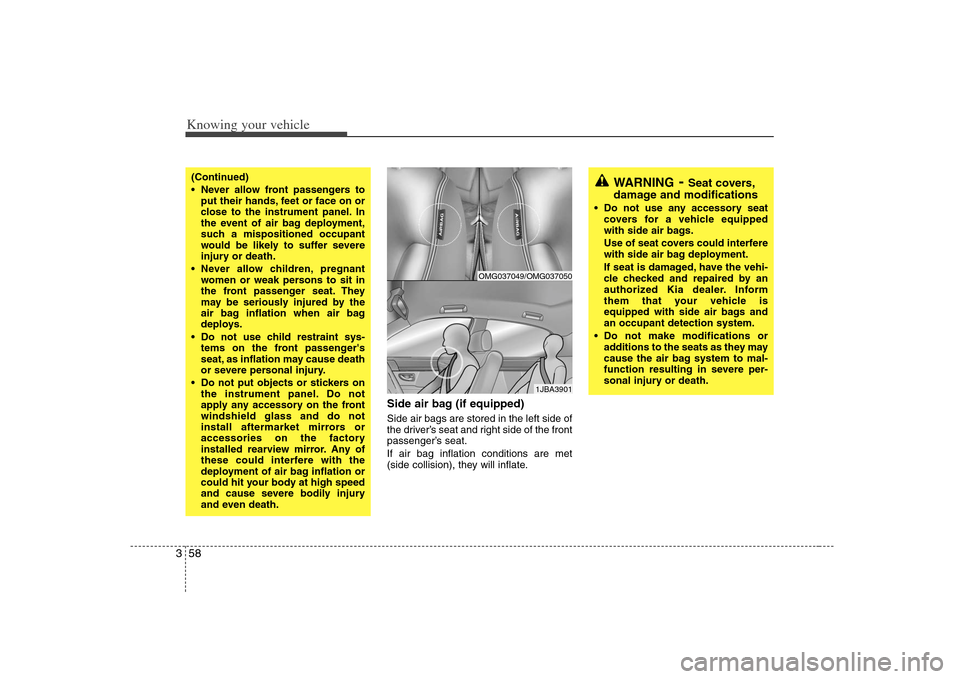
Knowing your vehicle58 3
Side air bag (if equipped)Side air bags are stored in the left side of
the driver’s seat and right side of the front
passenger’s seat.
If air bag inflation conditions are met
(side collision), they will inflate.
(Continued)
Never allow front passengers to
put their hands, feet or face on or
close to the instrument panel. In
the event of air bag deployment,
such a mispositioned occupant
would be likely to suffer severe
injury or death.
Never allow children, pregnant
women or weak persons to sit in
the front passenger seat. They
may be seriously injured by the
air bag inflation when air bag
deploys.
Do not use child restraint sys-
tems on the front passenger's
seat, as inflation may cause death
or severe personal injury.
Do not put objects or stickers on
the instrument panel. Do not
apply any accessory on the front
windshield glass and do not
install aftermarket mirrors or
accessories on the factory
installed rearview mirror. Any of
these could interfere with the
deployment of air bag inflation or
could hit your body at high speed
and cause severe bodily injury
and even death.
WARNING
- Seat covers,
damage and modifications
Do not use any accessory seat
covers for a vehicle equipped
with side air bags.
Use of seat covers could interfere
with side air bag deployment.
If seat is damaged, have the vehi-
cle checked and repaired by an
authorized Kia dealer. Inform
them that your vehicle is
equipped with side air bags and
an occupant detection system.
Do not make modifications or
additions to the seats as they may
cause the air bag system to mal-
function resulting in severe per-
sonal injury or death.
1JBA3901
OMG037049/OMG037050
Page 68 of 289
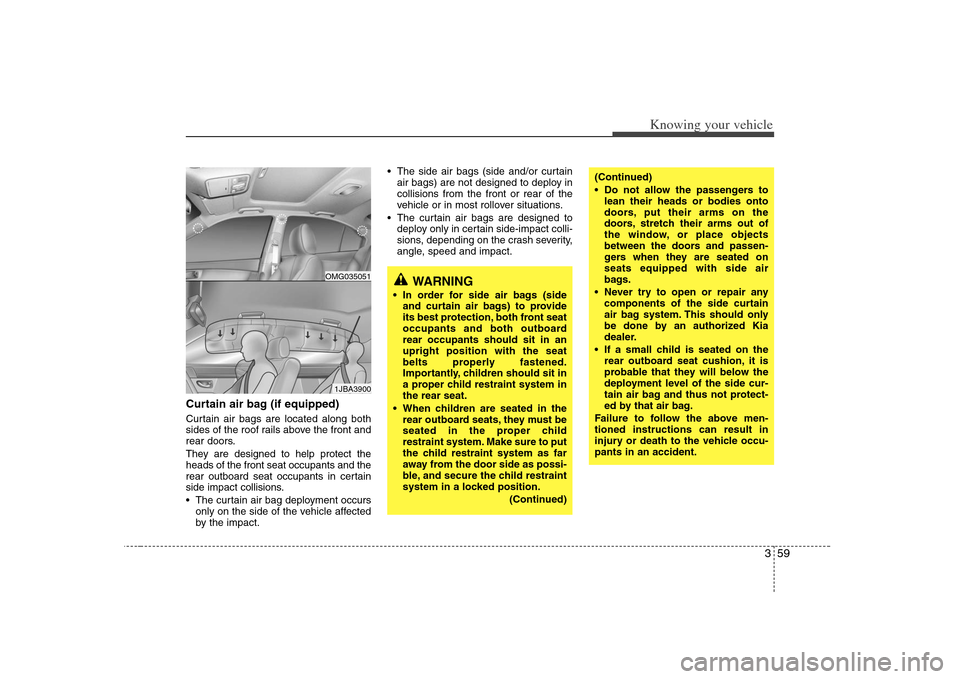
359
Knowing your vehicle
Curtain air bag (if equipped)Curtain air bags are located along both
sides of the roof rails above the front and
rear doors.
They are designed to help protect the
heads of the front seat occupants and the
rear outboard seat occupants in certain
side impact collisions.
The curtain air bag deployment occurs
only on the side of the vehicle affected
by the impact. The side air bags (side and/or curtain
air bags) are not designed to deploy in
collisions from the front or rear of the
vehicle or in most rollover situations.
The curtain air bags are designed to
deploy only in certain side-impact colli-
sions, depending on the crash severity,
angle, speed and impact.
WARNING
In order for side air bags (side
and curtain air bags) to provide
its best protection, both front seat
occupants and both outboard
rear occupants should sit in an
upright position with the seat
belts properly fastened.
Importantly, children should sit in
a proper child restraint system in
the rear seat.
When children are seated in the
rear outboard seats, they must be
seated in the proper child
restraint system. Make sure to put
the child restraint system as far
away from the door side as possi-
ble, and secure the child restraint
system in a locked position.
(Continued)
(Continued)
Do not allow the passengers to
lean their heads or bodies onto
doors, put their arms on the
doors, stretch their arms out of
the window, or place objects
between the doors and passen-
gers when they are seated on
seats equipped with side air
bags.
Never try to open or repair any
components of the side curtain
air bag system. This should only
be done by an authorized Kia
dealer.
If a small child is seated on the
rear outboard seat cushion, it is
probable that they will below the
deployment level of the side cur-
tain air bag and thus not protect-
ed by that air bag.
Failure to follow the above men-
tioned instructions can result in
injury or death to the vehicle occu-
pants in an accident.
1JBA3900OMG035051
Page 69 of 289
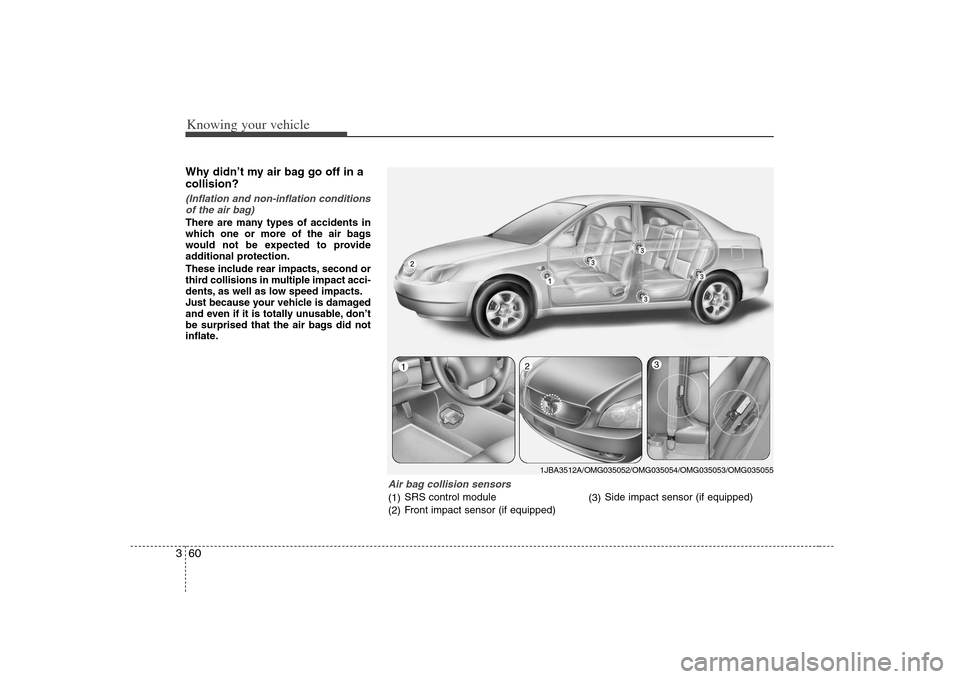
Knowing your vehicle60 3Why didn’t my air bag go off in a
collision? (Inflation and non-inflation conditions
of the air bag)There are many types of accidents in
which one or more of the air bags
would not be expected to provide
additional protection.
These include rear impacts, second or
third collisions in multiple impact acci-
dents, as well as low speed impacts.
Just because your vehicle is damaged
and even if it is totally unusable, don’t
be surprised that the air bags did not
inflate.
Air bag collision sensors(1)SRS control module
(2)Front impact sensor (if equipped)(3)Side impact sensor (if equipped)
1JBA3512A/OMG035052/OMG035054/OMG035053/OMG035055
1
2
3
Page 70 of 289
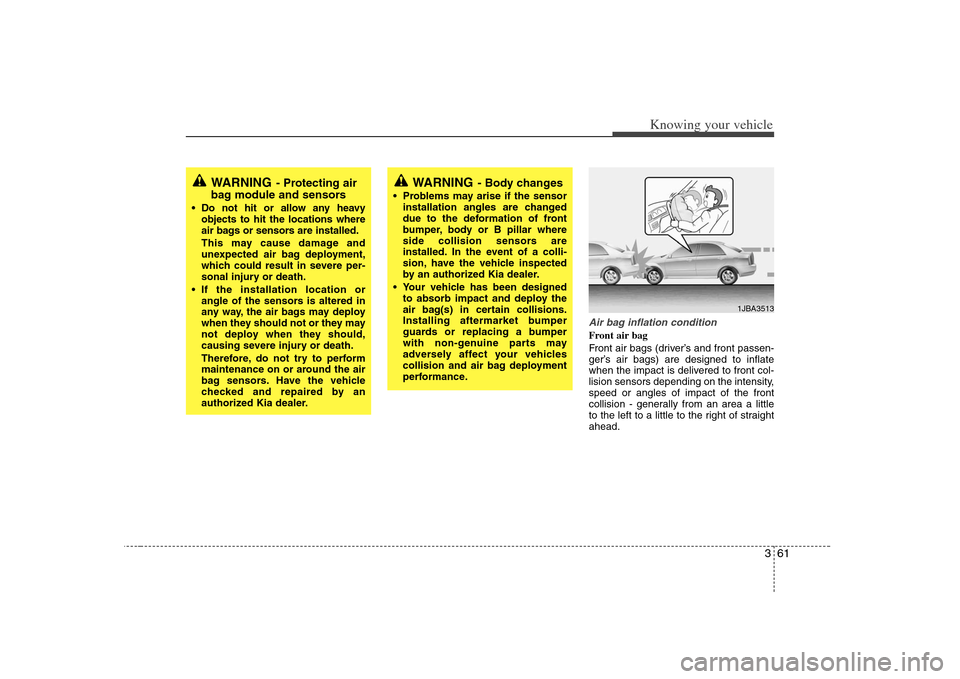
361
Knowing your vehicle
Air bag inflation conditionFront air bag
Front air bags (driver’s and front passen-
ger’s air bags) are designed to inflate
when the impact is delivered to front col-
lision sensors depending on the intensity,
speed or angles of impact of the front
collision - generally from an area a little
to the left to a little to the right of straight
ahead.
1JBA3513
WARNING
- Protecting air
bag module and sensors
Do not hit or allow any heavy
objects to hit the locations where
air bags or sensors are installed.
This may cause damage and
unexpected air bag deployment,
which could result in severe per-
sonal injury or death.
If the installation location or
angle of the sensors is altered in
any way, the air bags may deploy
when they should not or they may
not deploy when they should,
causing severe injury or death.
Therefore, do not try to perform
maintenance on or around the air
bag sensors. Have the vehicle
checked and repaired by an
authorized Kia dealer.
WARNING
- Body changes
Problems may arise if the sensor
installation angles are changed
due to the deformation of front
bumper, body or B pillar where
side collision sensors are
installed. In the event of a colli-
sion, have the vehicle inspected
by an authorized Kia dealer.
Your vehicle has been designed
to absorb impact and deploy the
air bag(s) in certain collisions.
Installing aftermarket bumper
guards or replacing a bumper
with non-genuine parts may
adversely affect your vehicles
collision and air bag deployment
performance.